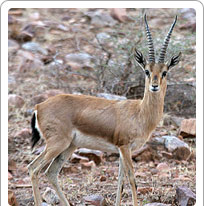Vibrant Rajasthan - Tour to the Land of History, Legends, Hotels....
- Pushkar Fair Tour Package
- Classical North India Tour Package with Nepal
- Palace on Wheels
- Colorful Heritage Rajasthan Tour Package
- Forts and Palaces of Rajasthan Tour Package
- Jewels of Rajasthan Tour Package
- Rajasthan Cultural Tour Package
- Splendours Of Rajasthan
- Pushkar Fair Tour with Golden Triangle
Kumbhalgarh Wildlife Sanctuary
Kumbhalgarh is a town located 65 km or about an hour and a half away from Udaipur located in the Rajsamand district of Rajasthan. The Kumbhalgarh wildlife sanctuary covers an area of 578 sq km and lies across the Aravali mountain at an altitude ranging from 500m to 1,300m.
It has an impressive bird and animal life that includes grey jungle fowl, peacock, ed spur owl, Parakeet, golden Oriole, grey Pigeon, Bulbul, Dove and white breasted kingfisher, jungle cat, jackal, sambhar, chinkara and hare as well as the rarely seen wolf. The uniqueness of this sanctuary is that it permits people to explore on horseback apart from trekking on foot.
The Kumbhalgarh town has a number of places of interest, not the least among them being the Kumbhalgarh Fort. Situated 1100m above sea level, the Kumbalgarh Fort was called the 'Eye of Mewar' due to its strategic position that commanded an excellent view of Gujarat and Marwar, its aggressive neighbours. To quote Col. James Tod, Annals and Antiquities of Rajasthan, 1829 "The fort rises, like the crown of the Hindu Cybele, tier above tier of battlements to the summit, which is crowned with the Badal Mahal, or 'Cloud Palace' of the Ranas". The Kumbhalgarh Fort is surrounded by thirteen mountain peaks.
The Kumbhalgarh Fort's perimeter wall is thirty-six km in length and is considered to be next only to the 'Great Wall of China'. The Fort and the town itself are named after Rana Kumbha who built it in the fifteenth century. The Fort has 360 temples within its precinct, out of which 300 are Jain temples and the rest are Hindu.
This Fort has a beautiful palace called the Badal Mahal Palace that was also the birthplace of Maharana Pratap. The palace is beautifully furnished in jewelled colours and is an amazing contrast to the grimness of the Fort. The fort was approached by crossing deep ravines and thick jungles and was considered quite invincible. The fort has seven gates, each with a special purpose or a story to tell.
Mirror signals could be sent from Arait Pol, the first gate, in case of emergency. Hulla Pol or the Gate of Disturbance was called so because the attacking Mughal army reached this spot in 1567 and great commotion. The resulting marks from cannon shots are still visible on the gate. Hanuman Pol is the third gate and has a temple dedicated to the Monkey God Hanuman. Bhairava Pol the fourth gate has a panel depicting the exiling of a treacherous Prime Minister in the 19th century.
The fifth gate, Paghra Pol or the Stirrup Gate was the place for the cavalry to assemble prior to action. The Star watchtower close by is an earlier structure and has 8m wide walls. The Topekhana Pol or the Cannon Gate supposedly has an underground passage leading to a secret escape tunnel. Nimboo Pol or the Gate of Lemon Trees, near the temple of Chamundi, is the seventh gate.
Accommodation
Kumbhalgarh town of Rajasthan offers a wide variety of accommodation options to tourists. If you wish to enjoy the royal past of Rajasthan, then stay at the heritage hotels such as Aodhi hotel and Kumbhalgarh Fort hotel. The Dera Kumbhalgarh luxury tents are best for those who want to delve into luxury in an adventurous style. Hotels falling into other categories are also available here.

- Kumbhalgarh Wildlife Sanctuary, Udaipur
Hot Selling Tours
- Kerala - God's Own Country
- Rajasthan Heritage Tour
- Sikkim Delight Tour
- Jewels Of Rajasthan Tour
- The Treasures of India & Nepal
- Temple and Spices Tour
- Best Of Two Cultures (Karnataka & Kerala)
- Backwater Beach Tours Kerala
- Golden Triangle Tour with Ajanta and Ellora
- Enchanting Kerala Tour
- Colourful Heritage Tour of Rajasthan
- Classical North India with Nepal
- Classical North India Tour
- Exotic Kerala Tour
- Rajasthan Forts And Palaces Tour
- Exotic South India Tour with Backwaters of Kerala
- Golden Triangle with Ranthambore Tour
- Golden Triangle Tour 5-6






